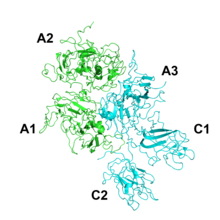Factor VIII (medication)

A depiction of factor VIII
|
|
| Clinical data | |
|---|---|
| Trade names | Aafact, octocog alfa, others |
| Routes of administration |
intravenous |
| ATC code | |
| Identifiers | |
| ChemSpider |
|
Factor VIII is a medication used to treat and prevent bleeding in people with hemophilia A and other causes of low factor VIII. Certain preparations may also be used in those with von Willebrand's disease. It is given by slow injection into a vein.
Side effects include skin flushing, shortness of breath, fever, and red blood cell breakdown.Allergic reactions including anaphylaxis may occur. It is unclear if use during pregnancy is safe for the baby. A purified factor VIII concentrate is made from human blood plasma. A recombinant version is also available. People may develop antibodies to factor VIII such that this medication becomes less effective.
Factor VIII was first identified in the 1940s and became available as a medication in the 1960s. Recombinant factor VIII was first made in 1984 and approved for medical use in the United States in 1992. It is on the World Health Organization's List of Essential Medicines, the most effective and safe medicines needed in a health system. The wholesale cost in the developing world is about 119.61 to 497.50 USD per 500iu vial.
This transfer of a plasma byproduct into the blood stream of a hemophiliac often led to the transmission of diseases such as HIV and hepatitis before purification methods were improved. In the early 1990s, pharmaceutical companies began to produce recombinant synthesized factor products, which now prevent nearly all forms of disease transmission during replacement therapy.
...
Wikipedia
